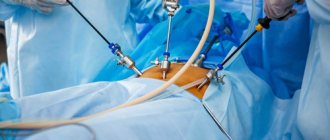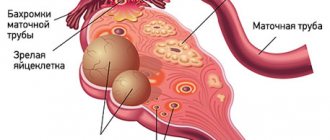How to check the patency of the fallopian tubes
Tubal obstruction
is a serious problem that prevents you from conceiving a child. But often women do not even suspect that pregnancy is possible; they just need to make an accurate diagnosis. The main method to accurately identify this is to check the pipes for permeability. Knowing how the fallopian tubes are checked for patency, you will not rely on unfounded diagnoses and speculation.
Pregnancy often occurs after diagnosis, since the procedure also has healing properties, since small adhesions are removed during the passage of contrast.
When should it be done?
In the absence of pregnancy, within one year of regular sexual activity without contraception, in order to diagnose the causes of infertility, to exclude the tuboperitoneal factor. True, it is important to understand that it is definitely not worth starting a woman’s examination with this procedure. If only because this in itself is not the most comfortable procedure, it can be accompanied by quite intense pain in the lower abdomen, for example. Therefore, the study should be done after all other factors have been excluded (male, ovarian (hormonal levels have been studied) and others).
This procedure is mandatory before planning intrauterine insemination (with the sperm of the husband or donor, it doesn’t matter). This is to ensure that the treatment will be effective and that there are no adhesions that could lead to an ectopic pregnancy.
After surgical interventions on the fallopian tubes (especially for ectopic pregnancy) after 6–12 months to ensure that their patency is not impaired, as well as after excision of adhesions to monitor the effectiveness of the operation.
Fallopian tube HSG, what is it?
Hysterosalpingography is the most informative test of fallopian tubes for patency in gynecology today. With its help, with almost 100% accuracy, you can confirm or refute the diagnosis of infertility, as well as identify other possible problems.
People often ask, tubal HSG, what is it? The mechanism of the procedure is quite simple. Through the cervical canal, the uterus and fallopian tubes are filled with a special contrast agent under pressure. If patency is normal, the solution enters the abdominal cavity without delay.
Using this procedure, not only is patency checked, but also the diagnosis of many diseases associated with disorders in the uterus is detected - the presence of pathologies of the uterine cavity (submucosal myomatous nodes, polyps, endometrium) is detected.
Before checking the patency of the fallopian tubes, an examination is required. It is necessary to do a smear on the flora, take a general blood test, and an infection test (hepatitis B, C, HIV, syphilis), and also do an ECG, because in our clinic HSG is performed under sedation. What it is and why it is necessary will be described below.
Hysterosalpingography is an absolutely safe procedure
. The study is recommended to be carried out in the first phase of the menstrual cycle, immediately after the cessation of menstruation. As a rule, HSG takes no more than 30 minutes.
Advantages and disadvantages of the ultrasound method
The advantages of ultrasound examination of fallopian tube patency include:
- speed,
- accuracy,
- safety,
- availability.
Ultrasound of fallopian tube patency is an outpatient procedure, that is, it takes place during one visit to the ultrasound room, which means there is no need for hospitalization.
Ultrasound is safe for the health of patients. A woman's ovaries are not exposed to harmful radiation, as during an X-ray of the fallopian tubes (hysterosalpingography or HSG). There are no abdominal punctures or incisions required, as with laparoscopy or fertiloscopy - diagnostic operations.
The accuracy of the study is about 90%, which is a good indicator. An incorrect ultrasound result can be obtained due to severe spasms. In this case, a repeat procedure is prescribed, because ultrasound of the patency of the fallopian tubes can be done repeatedly, unlike other diagnostic methods.
And finally, accessibility. The ultrasound method has a small number of contraindications, they can be eliminated and the study can be carried out. Moreover, the cost of the procedure will be lower than the cost of other diagnostic methods.
As for the disadvantages of ultrasound examination of the patency of the fallopian tubes, these include a certain discomfort from the insertion of a catheter and contrast agent and the tests required for the procedure, of which there are quite a lot. But, on the other hand, these tests will confirm that you are healthy, or help detect the disease at an early stage, which means it will be easier to cure, so this is not such a disadvantage.
Sedation or local anesthesia?
HSG must be performed under sedation. Sedation
- This is not general anesthesia, which has very unpleasant consequences, but drug-induced sleep, which has no side effects.
Carrying out HSG under sedation is necessary because with local anesthesia (or without anesthesia at all), a person cannot completely relax, and this, in turn, does not allow the uterus to relax. As a result, an incorrect diagnosis may be made. That is, you will be squeezed, the contrast will not be able to pass through the uterus, and the doctor may decide that you have an obstruction. You don't want to get a wrong diagnosis, do you? This is why we perform HSG only under sedation.
so that you get the most objective picture possible.
What will an ultrasound show?
Thanks to ultrasound of the appendages, it is possible to promptly diagnose diseases at the earliest stage of development, which will allow timely treatment to begin. Some pathologies may not manifest themselves in any way and can only be determined with the help of such a study. This is the value of ultrasound.
The following are clearly visible on ultrasound:
- An ovarian cyst
is the formation of a cavity surrounded by a dense capsule and filled with fluid. Usually the pathology does not manifest itself with severe symptoms. There may be a disturbance in the menstrual cycle, regular nagging pains at the bottom - closer to the sides, and the inability to get pregnant. - Polycystic ovary syndrome
is a collection of small cysts in the ovary that occurs due to hormonal imbalance. Polycystic disease manifests itself as menstrual irregularities, weight gain, acne, and infertility. - Salpingitis
is inflammation of the fallopian tubes due to infection through sexual intercourse. The pathology is characterized by the formation of adhesions that do not allow sperm to pass to the egg, therefore leading to infertility. - Salpingoophoritis
is an inflammation in the fallopian tubes and ovaries that occurs as a result of pathogenic microorganisms (staphylococci, streptococci, etc.) entering them. - Tumors of the ovaries and fallopian tubes
are benign and malignant formations that do not have cavities. - Ovarian torsion
is a twisting of the ovary (complete, partial), impairing blood flow to the organ. If torsion is detected, emergency surgical intervention is required. The pathology manifests itself as severe pain in the area of the diseased ovary, bloody leucorrhoea. All this is accompanied by nausea, vomiting, dysuria (urinary obstruction), and bowel dysfunction. The temperature rises. - Adnexal torsion is a spiral-shaped torsion of the fallopian tube with the ovary, often regarded as an adnexal tumor. It is characterized by sudden severe pain in the appendage area (lower abdomen, closer to the side). There is nausea and vomiting.
Where is it held?
The procedure is performed in the operating room and only in it
. Although this is an x-ray examination, it cannot be carried out in an x-ray room. This procedure must be carried out under sterile conditions, that is, the conditions must be the same as, for example, during operations on the heart or spine. Such conditions cannot be achieved in an X-ray room. Who sat in this place in front of you and with what illnesses? Therefore, only in the operating room.
If you decide to have an HSG done in our clinic, then the cost of hysterosalpingography (the price of the HSG procedure itself) is 10,000 rubles
.
The final cost of hysterosalpingography includes anesthesia and 3 hours of stay in our hospital, observation by doctors and nurses
and is
20,900 rubles
.
From October 1, 2021, the cost of GHA increases by 5,000 rubles.
Indications and preparation for echohysterosalpingoscopy
For patients with infertility, the study is performed to diagnose obstruction of the fallopian tubes and clarify treatment tactics. Patients with suspected intrauterine pathology in order to exclude or confirm the diagnosis.
Preparation for echohysterosalpingoscopy as for transvaginal ultrasound of the pelvic organs.
- For 2 days, it is recommended to follow a diet that reduces gas formation in the intestines. Eliminate plant foods (apples, cabbage, corn, legumes), carbonated drinks, beer, fatty meats and milk from your diet. If you have constipation, you should take a laxative the day before.
- The examination is carried out with moderate filling of the bladder, so the last urination should be 1 hour before the examination. A full bladder is a guide for determining the location of the internal genital organs.
Back to contents
Necessary examinations before the HSG procedure under sedation (during sleep)
- complete blood count + platelets + ESR - valid for 2 weeks;
- biochemical blood test (total protein, glucose, bilirubin, ALT, AST, alkaline phosphatase - valid for 1 month;
- coagulogram (APTT, PTI, fibrinogen, INR) - valid for 1 month;
- blood type, Rh factor (on a stamped form, a stamp in the passport is not accepted) - valid for an indefinite period;
- HIV - valid for 3 months;
- Wasserman reaction - valid for 3 months;
- HBs antigen - valid for 3 months;
- HCV antibodies - valid for 3 months;
- ECG - valid for 2 weeks;
- Flora smear is valid for 2 weeks.
How to check patency if for some reason an HSG is not possible? Read about such methods below, but they are outdated and uninformative
. Therefore, we do not recommend resorting to these types of diagnostics, but we consider it necessary to mention them.
Examination before echohysterosalpingoscopy
Mandatory checklist
- Preliminary consultation with examination in a gynecological chair.
- A study on the degree of purity of discharge from the vagina and cervical canal (if infections and inflammation are detected, preliminary treatment is indicated).
- Transvaginal ultrasound of the pelvic organs.
Additional examination list
- Blood tests for HIV (AIDS), RW (syphilis), Hepatitis B and C (according to indications).
- Examinations for sexually transmitted infections - STDs (if indicated).
- Clinical and biochemical blood test (according to indications).
- Clinical urine analysis (if indicated).
- Analysis of the blood coagulation system (if indicated).
- Heart function testing - ECG, EchoCG, etc. (according to indications).
- Consultation with a therapist and other related specialists (as indicated).
Back to contents
Additional treatments
Additional methods of treating tubal infertility are different options for physiotherapy:
- Electrophoresis
. It has an immunocorrective effect, which consists in exposing the area of the body where the drug is placed to a direct electric current. Medicines are absorbed through the skin in the form of positively and negatively charged ions. In addition, the electromagnetic field improves blood supply and resolves adhesions. - Balneotherapy
. It consists of treatment with mineral waters (nitrogen-siliceous, sodium chloride, hydrogen sulfide). The beneficial effects of medicinal water normalize hormonal levels, relieve pain and inflammation, and calm the nerves. - Ultrasound therapy
has shown high effectiveness in resolving adhesions. This is an in-office procedure in which local areas are exposed to ultrasonic waves. As a result, adhesions soften, blood circulation improves, and soft tissues become elastic. - Treatment with an electrical stimulator.
This way even old scars are eliminated. Using a special apparatus, the area of the fallopian tubes is exposed to electrical impulses with a frequency of 12 Hz. Muscle contraction occurs, as a result of which the lumen of the tube expands, scars and adhesions soften.
With minor damage to the appendages, gynecological massage will help. It is performed by a gynecologist in an examination chair, then the reproductive organs are manually massaged through the vagina. It is rarely used, but it is also quite effective and safe.
Traditional methods can also complement treatment. The boron uterus, which grows in Altai, has shown itself to be effective. It controls estrogen levels. The herb is brewed as a tea along with wintergreen, a plant in the heather family that has antiseptic and healing properties. St. John's wort, flax seeds, sweet clover, coltsfoot, and knotweed help eliminate tubal obstruction.
Treatment of adhesions in the appendages and other causes of obstruction
Is adnexal obstruction treatable? Yes, it is being treated, this is evidenced by numerous reviews that former patients post on forums. Treatment is carried out comprehensively and is aimed at eliminating the cause of the pathology - STIs, hydrosalpinx, etc.
Medication method
used in the treatment of acute forms of the disease. It consists of constantly taking medications at a certain dosage. The drugs have different effects on the body: some suppress the vital activity of pathogenic microorganisms, others relieve inflammation, and others resolve adhesions. Medicines are available in the form of tablets and suppositories.
Use of anti-inflammatory drugs:
- Non-steroidal (analgesics): simultaneously relieve inflammation, relieve pain and relieve fever. They block the production of enzymes - prostaglandins, produced when an infection enters the body. They are not synthetic, so they are taken longer than steroid drugs.
- Steroids (glucocorticosteroids are hormones produced by the adrenal glands). They are divided into natural and artificial. The principle of action is to suppress the production of leukocytes produced during inflammation. Tissue erosion at the site of inflammation disappears, pain and fever go away. But steroid drugs cannot be taken for a long time; they are effective for acute inflammation and severe forms of infection.
- Antibiotics
. A drug that destroys pathogenic bacteria can cure obstruction of the fallopian tubes, or more precisely, eliminate the cause of the dysfunction of the appendages - STIs. Antibiotics are taken under the supervision of a doctor in dosage. There is a threat that with long-term use, normal microflora will be suppressed. Therefore, before prescribing antibiotic treatment, the patient undergoes a test for the sensitivity of the microbe to the active substance. Throughout treatment, the types of antibiotics are changed so that microbes do not adapt to the drug. - Hormone therapy
. Often gynecological problems, including blockage of the lumen of the appendages, are caused by hormonal disorders. Depending on how tubal obstruction is treated, the patient is prescribed natural or synthetic hormones that suppress or restore the normal functioning of the organ. - The surgical method
is used in advanced cases, as well as when medication and physiotherapeutic methods become ineffective. Before surgery, the patient undergoes diagnostics to determine the impassable area. It is usually affected by adhesions, overgrown connective tissue or scars. There are various methods of surgical intervention, each of which is effective in a particular case.
Laparoscopy has proven itself to be excellent. This is a minimally invasive method in which the peritoneum of the patient is punctured in several places, and a laparoscope, a long tube with optics and a camera at the end, is inserted through the punctures. With the help of a camera, the image is visible on the screen, and the optics magnify it 3-4 times. The doctor removes adhesions and scars, instantly cauterizing the operated area.
In some cases, laparotomy relieves obstruction of the appendages. An incision is made along the bottom of the peritoneum through which surgery is performed. After the operation, a scar remains and the woman remains in the hospital for at least 5 days.
Reconstructive surgery works in a similar way. It involves transplanting a healthy section of the donor tube to the site of the damaged one. Or this is an artificial restoration of the lumen.
Where is tubal obstruction diagnosed and treated in St. Petersburg?
When faced with a problem, women ask the question: where and how to treat obstruction of the appendages, what to do? First of all, you need to go to a good clinic in St. Petersburg and establish the cause, and then eliminate the consequences. At the same time, you cannot self-medicate - this leads to the transition of the disease to an advanced form.
If you suspect tubal obstruction, seek qualified help at the Diana specialized clinic. Here you can inexpensively undergo examination using the latest equipment and be cured of infertility associated with this pathology.
If you find an error, please select a piece of text and press Ctrl+Enter
Hysterosalpingography: how is it performed?
Anesthesia is not required during the procedure. The procedure is painless; there may be a slight feeling of heaviness in the lower abdomen when a contrast agent is administered. When using X-rays, the radiation is minimal.
Before taking the picture, the doctor inserts a special tube into the uterus through which the solution is delivered. The image makes it possible to assess the condition of the uterus and the location of the fallopian tubes. The procedure takes on average 35-45 minutes.
In some cases, there may be bleeding for a week. Then the doctor may recommend medications to prevent inflammation. You can learn more about how hysterosalpingography is done from your doctor.








